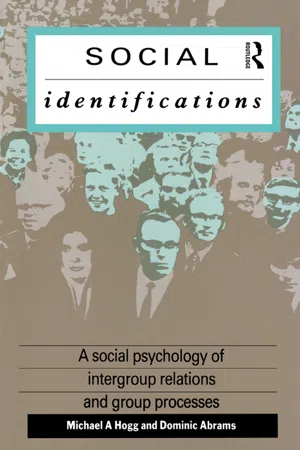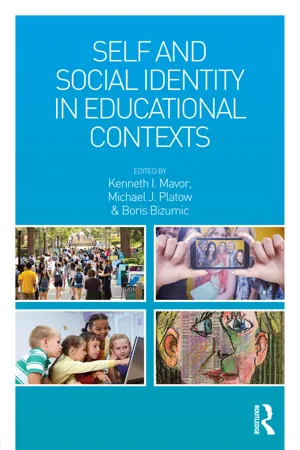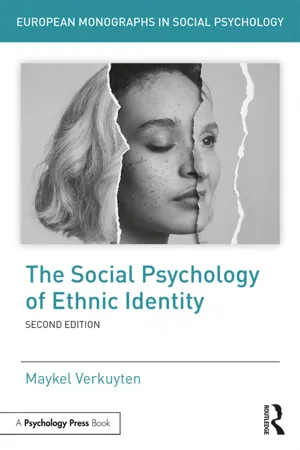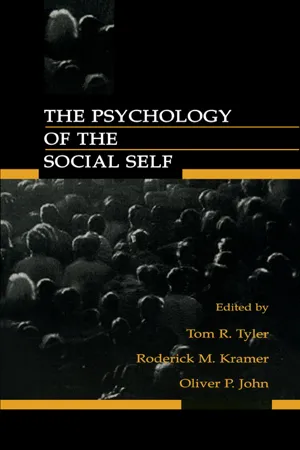Social Sciences
Social Identity
Social identity refers to the part of an individual's self-concept that is derived from their membership in a particular social group. This can include groups based on race, ethnicity, gender, religion, or other social categories. Social identity theory suggests that people categorize themselves and others into social groups, leading to in-group favoritism and out-group discrimination.
Written by Perlego with AI-assistance
Related key terms
11 Key excerpts on "Social Identity"
- eBook - ePub
The Construction of Exodus Identity in Ancient Israel
A Social Identity Approach
- Stargel(Author)
- 2018(Publication Date)
- Pickwick Publications(Publisher)
1The Social Identity Approach
S ocial identity was first defined as “that part of an individual’s self-concept which derives from his knowledge of his membership of a social group (or groups) together with the value and emotional significance attached to that membership.”1 That is to say, Social Identity was thought to include the following components:A cognitive component, in the sense of the knowledge that one belongs to a group; an evaluative one, in the sense that the notion of the group and/or of one’s membership of it may have a positive or a negative value connotation; and an emotional component in the sense that the cognitive and evaluative aspects of the group and one’s membership of it may be accompanied by emotions (such as love or hatred, like or dislike) directed towards one’s own group and towards others which stand in certain relations to it.2While this definition is still widely accepted, the term “Social Identity” has been used by a few to describe the gregarious aspect of individual identity. In response, some scholars have adopted the term “collective identity” to refer to group identity.3 Although this newer term provides clarity, both “Social Identity” and “collective identity” will be used interchangeably in this book since the former is used by the Social Identity Theory (SIT) and the Self-Categorization Theory (SCT), which are central to our methodology.Collective identity should not be equated with one’s beliefs, values, language, culture, and so on. People first come to the realization they are a distinct people and then they define themselves in relation to certain cultural indicia that change over time.4 Collective identity tends to be a dynamic entity, and not something static forced on groups by others or by circumstances. Such a view acknowledges groups as active agents in the making and remaking of their identities over time. Collective identities are perceived as identities that people “accept, resist, choose, specify, invent, redefine, reject, actively defend, and so forth. They involve an active ‘we’ as well as a ‘they.’ They involve not only circumstances but also active responses to circumstances by individuals and groups, guided by their own preconceptions, dispositions, and agendas.”5 This constructionist view of collective identities is presumed here. The validity of the assumption will be confirmed by findings of variability in identity formulations in exodus narratives.6 - eBook - ePub
Social Identifications
A Social Psychology of Intergroup Relations and Group Processes
- Dominic Abrams, Michael A. Hogg(Authors)
- 2006(Publication Date)
- Routledge(Publisher)
Social Identity as a means of resolving this issue.Introduction
Social Identity is defined as ‘the individual’s knowledge that he belongs to certain social groups together with some emotional and value significance to him of the group membership’ (Tajfel 1972a: 31), where a social group is ‘two or more individuals who share a common social identification of themselves or, which is nearly the same thing, perceive themselves to be members of the same social category’ (Turner 1982:15). These quotations convey some fundamental aspects of the Social Identity approach. Identity, specifically Social Identity, and group belongingness are inextricably linked in the sense that one’s conception or definition of who one is (one’s identity) is largely composed of self-descriptions in terms of the defining characteristics of social groups to which one belongs. This belongingness is psychological , it is not merely knowledge of a group’s attributes. Identification with a social group is a psychological state very different from merely being designated as falling into one social category or another. It is phenomenologically real and has important self-evaluative consequences.In this chapter we present the Social Identity approach, its assumptions, its theoretical propositions, and its scope. This is intended to be a theory chapter to equip the reader for subsequent chapters which explore specific topics that the approach addresses. In turn, these later chapters will provide the empirical findings which have bearing on the theory and will dwell in more detail and elaborate upon those aspects of theory relevant to the topic. However, before doing this we shall spend some time contextualizing the approach. We feel it is very important to show where the Social Identity perspective fits in social psychology: how it differs from other perspectives, what assumptions it shares. Here we are really concerned with metatheory, with what type - eBook - ePub
- Kenneth I. Mavor, Michael J. Platow, Boris Bizumic(Authors)
- 2017(Publication Date)
- Routledge(Publisher)
One of the fundamental principles of Social Identity theorising is that group membership will only have an impact upon individuals’ behaviour to the extent that it is internalised into their sense of self as part of their Social Identity – so that ‘we’ becomes part of ‘me’. Indeed, Tajfel’s definition of Social Identity as ‘the individual’s knowledge that he [or she] belongs to certain social groups together with some emotional and value significance to him [or her] of this group membership’ (1972, p. 292) makes it clear that a group membership needs to be psychologically significant for a person in order for it to have psychological (and behavioural) impact on them.This point was confirmed in some of the original laboratory studies out of which Social Identity theory developed. These minimal group studies involved schoolboys being asked to assign points (signifying small sums of money) to members of two different groups – one to which they apparently belonged and one to which they did not (Tajfel, Flament, Billig and Bundy, 1971). The groups had no prior meaning (being based on things such as liking for abstract paintings that the boys did not know), and yet the boys used them as a basis for their behaviour – generally giving more points to boys who were in their own group (the ingroup) than they did to those who were in the other group (the outgroup). Importantly, though, subsequent studies demonstrated that this pattern of ingroup favouritism was only shown by participants who identified with the minimal groups to which they had been assigned. Those who did not were ‘left cold’ by the minimal group procedure and it had little impact on their behaviour (Gagnon and Bourhis, 1996; see Spears and Otten, 2012).This same point also holds in the world of groups outside the laboratory, where social identification proves to be a more or less universal moderator of group-based social behaviour. For example, while people tend generally to like and trust ingroups more than outgroups, to feel more connected to their members, and to communicate and work better with them, these effects are more marked for high identifiers than for low identifiers (for reviews, see Haslam, 2001; Ellemers, Spears and Doosje, 1999). - eBook - ePub
- Maykel Verkuyten(Author)
- 2018(Publication Date)
- Routledge(Publisher)
but in what there is to be known about social categories . Social psychology has clearly shown that these are different things. An individual fits into many different categories, some of which are shared with some people and some shared with others, but never all of them shared with anyone else. A social category lumps together people who may be very different in all other respects. But what they share in characteristics through membership of the category, at least for the moment and for the purpose or circumstances of the designation, is supposed to outweigh all those differences.p.80 Three interrelated componentsSocial Identity is about socially defined and recognized distinctions and designations. However, not all classifications into which a person fits become established and socially meaningful identities. We make lots of temporary and generalizing distinctions about ourselves and others all the time, such as in terms of mood, tastes and preferences. Social identities related to ethnicity, nationality, race and religion involve more enduring collective definitions and intersubjective understandings. For the membership of a collectivity of some sort to form a real Social Identity, a combination of three interrelated related components is needed:(1) social classification, or the sociostructural component;(2) specific behavioural and normative consequences and expectations bounded to the category, or the cultural component; and(3) judgements of an ontological nature , or the ontological component.Together, these three are the necessary aspects of social identities. Obviously, the three are closely linked. It is the combination of the three that gives a social label the required ‘identity depth’. Hence the distinction is an analytic one that allows us to ask specific questions and examine interrelations.Gender identity is a ready example. There are no cultures in the world that do not make a clear distinction (1) between men and women in their classification of things, (2) in the way in which the two sexes are expected to behave and (3) in what they are supposed to be like as human beings. The identity potential of the sex difference is enormous. This does not mean that the characteristics imposed or expected to exist are in any way natural or inevitable. Even here, although the role differentiation is biologically given to a certain extent, there are extreme differences between cultures in prescribed behaviour for the sexes and in gender-related development. I will elaborate on these three components in the next sections. - eBook - ePub
The New Psychology of Leadership
Identity, Influence and Power
- S. Alexander Haslam, Stephen D. Reicher, Michael J. Platow(Authors)
- 2020(Publication Date)
- Routledge(Publisher)
social competition.In terms of our present focus on leadership, Social Identity theory makes four contributions that are essential for the analysis we want to develop. The first is to expound the central concept of Social Identity – the notion that our sense of self can be derived from our group membership and the meanings associated with that group membership. The second is to recognize that different forms of intergroup behavior stem from the definition of the norms and values associated with this Social Identity. The third is to establish that, when social identities are operative (or salient), what counts for an individual is the fate and the standing of the group as a whole, not his or her fate as an individual. The fourth is to observe that the nature of groups and of group processes is always bound up with social context. In particular, if the meaning of who we are depends on comparisons with “them,” then our own social identities will shift as a function of who we are comparing ourselves to in any given context.Social Identity theory introduces us to these concepts, but they are more fully developed, made more explicit, and given wider application to group processes in general (including processes within groups as well as processes between groups) in a second phase of Social Identity theorizing. This phase centers around the development of self-categorization theory. This theory will be the focus of our interest in the remainder of this chapter because it provides us with the essential conceptual tools for crafting a new psychology of leadership.Self-categorization theory
Returning to the minimal group studies, for John Turner (1982) the most important implication of their findings was that they suggested that the mere act of individuals categorizing themselves as group members (i.e., defining themselves in terms of a given Social Identity) was sufficient to produce group behavior. What these studies showed very powerfully was that it was not interdependence, economic exchange, or attraction that led to group behavior but the cognitive process of defining oneself in terms of group membership. We only act as group members because, and to the extent that, we are able to think about ourselves as “we” and not just “I.” As Turner famously put it: “Social Identity is the cognitive mechanism which makes group behavior possible - eBook - ePub
Social Psychology
Fourth Edition
- Eliot R. Smith, Diane M. Mackie, Heather M. Claypool(Authors)
- 2014(Publication Date)
- Psychology Press(Publisher)
The chapter concludes with a discussion of the effects of belonging to a group that others look down on. From playgrounds to boardrooms, being Muslim, speaking with an accent, using a wheelchair, being gay or lesbian, or being on welfare can provoke scorn, dislike, and avoidance. Such negative group identities can take their toll on individuals and groups. But this outcome is not inevitable, and the chapter concludes by describing how people resist the implications of a negative identity and even work to change society’s evaluation of their groups.CATEGORIZING ONESELF AS A GROUP MEMBER
Some group memberships are so important that they become a basic part of our view of ourselves. Try asking a friend to take a piece of paper and write 10 different sentences beginning “I am …” When people perform this task they typically list some individual characteristics such as “I am outgoing” or “I am tall,” but they also list group memberships: “I am a woman,” “I am German.” In fact, most people list more group than individual characteristics (M. H. Kuhn & McPartland, 1954). The process of seeing oneself as a member of a group is known asself-categorization(J. C. Turner, Hogg, Oakes, Reicher, & Wetherell, 1987). Self-categorization is flexible and can readily shift (Mussweiler, Gabriel, & Bodenhausen, 2000). Depending on the social context, for example, sometimes you may see yourself as a Mexican-American, other times as a student, and still other times as a unique individual, with group memberships temporarily receding into the background. The termSocial Identityrefers to the way we feel about the group memberships that we share with others (M. Rosenberg, 1979; Tajfel, 1972). Social Identity turns “I” into “we”; it extends the self out beyond the skin to include other members of our groups—and, as we will see, it generally involves positive feelings about both ourselves, and those others.self-categorizationthe process of seeing oneself as a member of a social groupSocial Identitythose aspects of the self-concept that derive from an individual’s knowledge and feelings about the group memberships he or she shares with othersAlthough some group memberships are only fleetingly important—being part of the “white shirts” team in a lunch-hour basketball game, for example—most group memberships are stable and enduring. Membership in gender and ethnic groups lasts a lifetime. Being a member of the Kardashian or the Hilton family, or being Muslim, Roman Catholic, or Buddhist can be just as long-lasting. How do we learn what characteristics are associated with our groups? - eBook - ePub
- Tom R. Tyler, Roderick M. Kramer, Oliver P. John(Authors)
- 2014(Publication Date)
- Psychology Press(Publisher)
Part II The Nature of the Social SelfPassage contains an image
Chapter 4 Connecting the Person to the Social: The Functions of Social Identification
Kay Deaux Anne Reid Kim Mizrahi Dave Cotting City University of New YorkDOI: 10.4324/9781315805689-4After decades of emphasizing the individual, U.S. social psychologists have rediscovered the social self. Nudged by their European colleagues, who have typically placed more emphasis on group-level phenomena (Doise, 1986 ), significant numbers of U.S. investigators have turned their attention to questions that address the links between self and others. Social psychologists are theoretically committed to exploring the links between individuals and their social worlds. Yet, with our skill in creating specific social settings for experimental participants, we sometimes fail to pay attention to the larger social system in which people actually engage, choose, respond, and despair. A comprehensive analysis of the social self needs to attend to these issues and to develop theoretical models that explicitly incorporate the social as well as the individual.Social identification, we argue here, is a key conceptual link between the individual and society. When a person defines him- or herself in terms of a category or group of somehow similar people, the person takes on shared meanings of that categorical label’s implication, as well as assuming elements of a common agenda for action. These collectively defined meanings and actions are part of the social climate, the social representations constructed and conveyed to members of a society (Moscovici, 1988 ). At the same time, individuals bring to their claims of category membership a set of unique experiences and possibly idiosyncratic reasons for claiming that identity. At this juncture between the individual and the societal, social identification can play a critical role.The analysis of Social Identity owes a debt to the theorizing of Henri Tajfel (1978) . In developing Social Identity theory, Tajfel and his colleagues, most notably John Turner, proposed a coherent account of how people define themselves, not solely in terms of individual characteristics but also as part of a group of people with whom some traits, emotions, and actions are shared. As a theory of intergroup behavior, in particular, Social Identity theory has led the way for more than a generation of social psychologists. Although we acknowledge our debt to Social Identity theory, our analysis is not strictly tied to that theoretical framework. Indeed, part of our concern with the motivations that lead to social identification is prompted by a realization that Social Identity theory has not adequately explored the varying functions1 that identification might serve (also see Deaux, 1996 ). Other models of Social Identity, including those of sociologists such as Stryker (1980) and McCall and Simmons (1978) - eBook - ePub
The New Psychology of Health
Unlocking the Social Cure
- Catherine Haslam, Jolanda Jetten, Tegan Cruwys, Genevieve Dingle, S. Alexander Haslam(Authors)
- 2018(Publication Date)
- Routledge(Publisher)
Chapter 1 . In particular, this is because they challenge the dominant model of the self that prevails in psychology (and in Western society as a whole) which sees the true nature of the person as residing in their immutable individuality, and hence which sees pathways to health as largely requiring engagement with, and mobilisation of, this individuality and an associated sense of personal identity.The alternative view that we have set out does not question the importance of individuality or personal identity for our sense of personhood or for our behaviour. However, it suggests that this is most likely to have an impact on health and well-being where it emerges out of, rather than independently of, meaningful group memberships (Greenaway et al., 2015; Jetten et al., 2015). Indeed, more generally, we suggest that people’s internalised group memberships – that is, their social identities – can be an essential source of psychological robustness and resilience. In large part this is because, as we have seen, social identities constitute key psychological resources of the form summarised in Figure 2.8 . Moreover, as well as being psychological, these resources have important material consequences for the groups they are members of and for the social world that those groups are part of.This can be seen clearly in each of the three examples with which we started this chapter. In Sardinia, the residents of the mountain villages are observed to have a fierce and proud sense of their shared and distinctive identity (Pinker, 2015); at the Magh Mela pilgrims revel in the opportunity to live out their shared religious faith (Tewari et al., 2012); in outback Australia resilient farmers report feeling a strong sense of belonging with others in their community that helps them to cope with the adversity of drought and hardship (McLaren & Challis, 2009; McPhedran & De Leo, 2013b; Schirmer, Mylek, Peel, & Yabsley, 2015). In all these cases it is not simply personal resilience or hardiness that protects health; rather this seems to flow from depersonalised connections between people that are a source of support, solidarity, and strength. - eBook - ePub
Trust in Risk Management
Uncertainty and Scepticism in the Public Mind
- Timothy C. Earle, Michael Siegrist, Heinz Gutscher(Authors)
- 2010(Publication Date)
- Routledge(Publisher)
The Social Identity perspective has its roots in research by Tajfel during the late 1960s and the early 1970s on social categorization, inter-group relations, discrimination and cognitive aspects of prejudice (see Tajfel, 1969; Tajfel and Turner, 1979). Since then, it has developed into an integrative social psychological analysis of the relationship between collective self-construal (Social Identity) and group processes and inter-group relations (for recent conceptual and empirical overviews, see Turner, 1999; Abrams and Hogg, 2001; Hogg, 2001a, 2003, 2005a; see also Hogg and Abrams, 1988). The Social Identity perspective has a number of compatible and integrated conceptual components. These deal, for example, with the structure of self (for example, Turner, 1982); processes of social comparison (see Hogg, 2000a); self-enhancement and uncertainty reduction motives (Abrams and Hogg, 1988; Hogg, 2000b); social influence and conformity (see Turner, 1991); inter-group relations (Tajfel and Turner, 1979); and the generative role of social categorization (Turner et al, 1987).At the heart of the Social Identity perspective is the view that group phenomena are associated with people identifying and evaluating themselves in terms of the defining attributes of a group that are shared by fellow members. Group phenomena are associated with collective self-conception in terms of a specific group membership – Social Identity (we/us versus them). Social Identity is distinguished from personal identity – self-definition in terms of close personal relationships and/or attributes that are thought to be uniquely or idiosyncratically self-defining (I/me versus you). The Social Identity perspective does not elaborate upon personal identity or personal identity-related phenomena.Categories, Prototypes and SaliencePeople represent social categories (groups) as prototypes. Prototypes are fuzzy sets of attributes (beliefs, attitudes, feelings, perceptions and behaviours) that capture similarities within a group at the same time as they also capture differences between groups. Prototypes are governed by the principle of meta-contrast (they are composed in such a way as to maximize the ratio of inter-group differences to intra-group differences), and so accentuate category distinctiveness and entitativity (the extent to which a category has the properties of a distinct and bounded entity). As such, prototypes have two other important features. The prototype usually describes the ideal, not the typical or average group member (the prototype is often polarized away from a specific out-group and is therefore more extreme than the average in-group member), and prototypes can vary from context to context as a function of the out-group that the in-group is compared against. - eBook - ePub
Communicating Successfully in Groups
A Practical Guide for the Workplace
- Richard Hammersley, Marie Reid(Authors)
- 2014(Publication Date)
- Routledge(Publisher)
6 The social construction of identityObjectives
By the end of this chapter you should understand the six basic ideas about identity that are listed below.Basic ideas about identity
We will draw upon both psychology and sociology and offer you six basic ideas:- Identity is fluid, dynamic and negotiable.
- Identity is communicative. We signify our social identities to other people, interpret feedback from them about what we are like and may modify our identities on the basis of that feedback.
- Our stable personal identities are constructed to make sense of what has happened to us and how we have related to other people.
- People’s identity constructs are usually socially functional for them, and this can apply even to deviant, damaged or spoiled identities.
- Identity involves identification with specific groups of people, but also contribution to the nature of those groups; this is a fundamental aspect of social activity.
- People routinely adopt different identities in different social groups; hence the idea of a social role.
The last two points will be covered in detail in other chapters. It follows from these key points that although you are often defined by your interactions with others, you can also change yourself and how others see you. Furthermore, this is easier to accomplish if you have good communication skills and awareness of how social processes work. To a certain extent it is possible to adjust your identity by managing how others perceive and judge you, although this does not mean that you should be manipulative about it. Indeed, people tend to disapprove of others who are overly concerned to present whatever identity seems the most socially convenient at the time.Identity is fluid, dynamic and negotiable
As we will see in Chapter 10 - Constantine Sedikides, Marilynn B. Brewer(Authors)
- 2015(Publication Date)
- Psychology Press(Publisher)
The self-categorization process is even more striking when we consider the change in self-category content as we moved from personal to Social Identity. The observation that Social Identity functioned to the exclusion of the personality variable is important. This finding clearly challenges the long-standing assumption in social psychology that the self can be conceived as fixed at the personal level.This study and others like it suggest that change and stability in the self can be understood in terms of implicit and explicit self-categorization processes. Clearly, much more work needs to be done, particularly with regard to developing and testing an adequate process-based (as opposed to structural) account of stability in self-relevant judgments. Nevertheless, our research suggests the viability of such an account. Moreover, it supports the general conclusion that the self is the expression of a flexible process of social judgment (Turner et al., 1994).Figure 9.1. Contextual interpretation of schema-type effects in a modified version of the Markus paradigm.CONCLUSION
Gordon Allport once stated “the existence of one’s own self is the one fact of which every mortal person—every psychologist included—is perfectly convinced” (1943, p. 451). Despite this consensus, the question of precisely what form the self takes remains a topic of much debate. It can be argued that the cognitive revolution in social psychology has produced a dramatic shift away from the more “contextualist” perspectives of the early theorists (Rosenberg, 1988). The self-concept currently is conceived as a stable, separate, and bounded cognitive structure. Personality theories of the self and questions about how self-relevant knowledge is mentally organized and processed have taken center stage. Not surprisingly then, self-concept change has come to be understood as a matter of reconfiguring the personality structures that constitute the self-concept. The relevant theoretical models and experimental paradigms have tended to neglect the pervasive influence of the other and the psychological group on the phenomenal self. In this chapter, we have argued that, at some level, the psychological group (in the general sense of an abstract “us,” or in the more particular sense of a specific group membership) is implicated in the experience of all self-concepts. This idea is at the foreground of self-categorization theory, but has not, in our view, penetrated mainstream social cognition research on the self. Insofar as attention is refocused on the nexus between the psychological group and the self-concept, the field of social psychology arguably will be in a good position to achieve a more adequate integration of the social and the cognitive aspects of the self and understand better the forces making for self-concept stability and change.
Learn about this page
Index pages curate the most relevant extracts from our library of academic textbooks. They’ve been created using an in-house natural language model (NLM), each adding context and meaning to key research topics.










